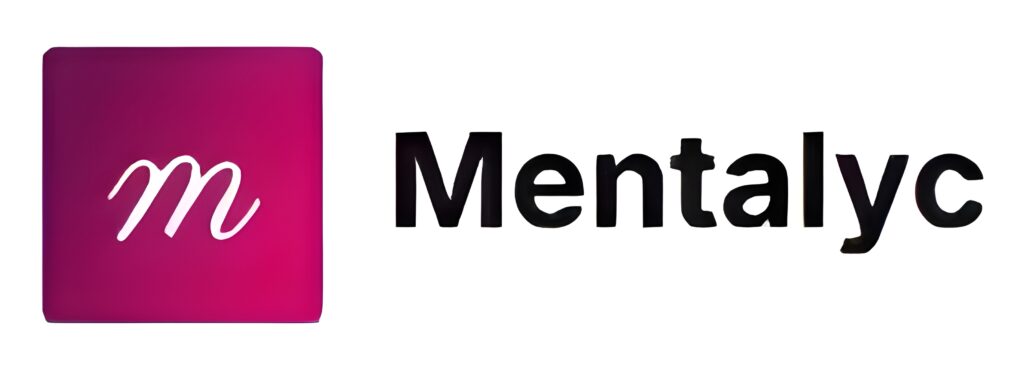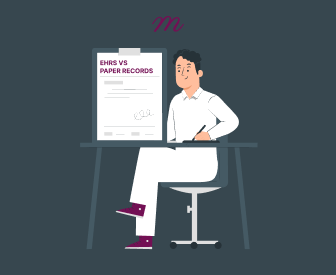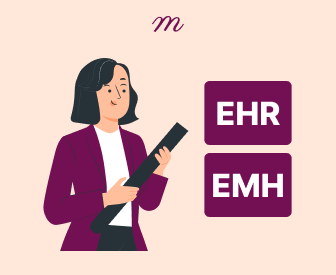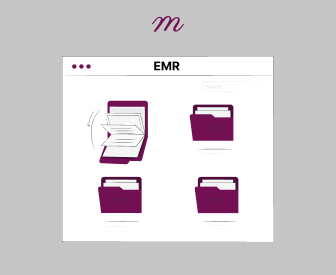Have your progress notes written for you automatically
Electronic health records (EHRs) are the backbone of efficient and effective clinical practice management. Yet many therapists still rely on traditional paper records, whether out of habit, perceived convenience, or apprehension about change. While paper records have served the field well for decades, the advantages of EHRs are impossible to ignore (Clay, 2012). This article explores why therapists should consider switching to EHRs, offering practical reasons and addressing common concerns.
EHRs: The Pros
1. Enhanced Organization and Accessibility
Electronic records are stored digitally, making them accessible from any device. Need to review a client’s progress notes before a session? With EHRs, it’s just a click away. EHRs save time and reduce the risk of losing important information. Therapists can quickly search for specific keywords, diagnoses, or treatment plans, especially helpful during audits or consultations.
Managing paper records often involves bulky filing systems, color-coded tabs, and time-consuming searches for misplaced documents.
2. Improved Client Privacy and Security
Modern EHR systems are equipped with encryption and password protection, ensuring compliance with HIPAA and other privacy regulations. Protecting client confidentiality is essential, and EHRs minimize the risks associated with physical storage—allowing controlled access to sensitive information.
Physical files are vulnerable to theft, damage, and unauthorized access. A single misplaced chart could lead to a privacy breach!
3. Streamlined Administrative Tasks
Automation features like note templates, billing integration, and appointment scheduling reduce administrative burdens. With EHRs, therapists can use prebuilt templates for intake forms, SOAP notes, or treatment plans, cutting documentation time in half. Automated reminders for upcoming sessions or outstanding payments improve workflow efficiency.
Writing, filing, and organizing paper records take up valuable time that could be spent on client care.
4. Enhanced Coordination and Communication
EHRs enable seamless information sharing through secure communication portals or direct access to relevant parts of a client’s file. Collaboration is vital, particularly for clients with complex needs. EHRs ensure that care is cohesive and timely, improving outcomes.
Previously, sharing client information with other providers, such as psychiatrists or primary care physicians, involved copying and faxing pages—a process prone to errors and delays.
Comparing Costs: The Long-Term Benefits of EHRs
Switching to an EHR system may seem burdensome due to upfront costs, including software licenses, training, and new hardware. However, the long-term savings far outweigh these initial expenses. EHRs eliminate physical storage costs and reduce time spent on administrative tasks, saving money in the long run.
Paper records require continuous purchases of supplies such as folders, filing cabinets, and storage space—expenses that add up over time.
Investing in an EHR system pays dividends through improved efficiency, fewer errors, and better client retention. Therapists who implement EHRs often report seeing more clients per week due to reduced time spent on paperwork, directly increasing revenue (Upadhyay & Hu, 2022).
Key Features of EHRs That Transform Practice Management
1. Telehealth Integration
Telehealth is here to stay in the post-pandemic world. Many EHR systems integrate telehealth platforms directly, allowing therapists to conduct virtual sessions and easily document progress notes. With platforms like SimplePractice or TheraPlatform, therapists can schedule, conduct, document, and bill telehealth sessions all in one place.
2. Billing and Insurance Simplification
Billing can be a headache for therapists, mainly when dealing with insurance claims. EHRs automate this process, as well as invoicing, tracking payments, sending reminders, and generating superbills for clients—all while ensuring accuracy. Paper records require manual tracking of payments and claims, leading to potential errors and delayed reimbursements. Dr. Smith uses an EHR system, and she sets up automated invoicing. After each session, the system automatically generates a superbill with accurate CPT codes and electronically submits claims to the insurance company. It also tracks payment statuses and sends reminders to clients about outstanding balances. This process eliminates the need for manual calculations and reduces errors, ensuring Dr. Smith gets reimbursed promptly.
3. Customizable Templates
EHR systems come with prebuilt templates for progress notes, treatment plans, and assessments, which can be customized to fit a therapist’s specific needs. Custom templates reduce the cognitive load of repetitive documentation, ensuring that therapists spend less time on paperwork and more time with clients. Ms. Aronson specializes in treating anxiety disorders and customized a prebuilt progress note template in her EHR system.
The template includes dropdown menus for common interventions, symptom checklists, and sections for session goals. During sessions, she quickly completes the note with a few clicks, saving time and ensuring consistency in documentation while tailoring the template to her specific workflow.
4. Reporting and Analytics
EHRs provide valuable insights into practice trends, such as client demographics, session attendance rates, and revenue patterns. Therapists can use this data to refine their services, identify growth opportunities, and ensure their practice remains sustainable. Dr. Jamison notices through his EHR’s reporting feature that a significant percentage of his clients are young adults aged 18–25 seeking help for depression. The data also reveals that evening appointments are most in demand. Using these insights, he adjusts his schedule to offer more evening slots and develops a targeted workshop on managing depression for young adults, increasing client satisfaction and boosting practice growth.
Overcoming Common Concerns About EHRs
1. “I’m Not Tech-Savvy.”
Many therapists hesitate to switch to EHRs due to a perceived lack of technical expertise. However, most modern EHR platforms are designed with simplicity in mind.
Solution: Choose a user-friendly system like SimplePractice or TherapyNotes, which offers extensive onboarding support, video tutorials, and customer service.
2. “I Don’t Have the Time to Transition.”
Switching to EHRs may initially feel overwhelming, but with the proper planning, the process is often quicker than expected.
Solution: Implement the transition gradually by starting with new clients or specific types of records. Many EHR providers also offer data migration services to streamline the process.
3. “What if My System Crashes?”
Therapists worry about losing access to records during technical failures. However, most EHRs offer cloud-based storage with automatic backups.
Solution: Opt for a reputable EHR provider with 24/7 technical support and reliable data recovery systems.
4. “Is It Secure Enough?”
EHRs must comply with stringent HIPAA regulations, making them inherently more secure than paper records in many ways.
Solution: Confirm that the EHR provider uses encryption, secure logins, and multi-factor authentication to protect sensitive data.
5. “What if It’s Too Expensive?”
Many therapists fear the cost of EHR systems will outweigh the benefits, especially for solo practitioners or small practices.
Solution: Many EHR providers offer tiered pricing plans to accommodate different practice sizes and needs. Look for affordable options like monthly subscriptions that include essential features or start with a basic plan and upgrade as your practice grows. Additionally, the time saved on administrative tasks often offsets the initial investment.
6. “Will It Disrupt My Workflow?”
Therapists often worry that transitioning to an EHR will complicate or slow down their established processes.
Solution: Choose an EHR system with intuitive workflows and customizable templates that align with your practice needs. Many systems offer free trial periods so you can test how they integrate into your day-to-day operations before committing.
Advantages for Clients
Switching to EHRs doesn’t just benefit therapists; it also improves the client experience:
1. Enhanced Transparency
Clients can access their own records through client portals, promoting transparency and collaboration in their care.
2. Better Scheduling and Reminders
Automated appointment reminders reduce missed sessions, ensuring clients stay consistent with their treatment plans.
3. Streamlined Payment Options
With EHR-integrated billing, clients can pay online, making the process simpler and more convenient.
4. Improved Communication
EHR systems often include secure messaging platforms, allowing clients to communicate with their therapists between sessions. This enables timely support when needed.
5. Easy Access to Forms and Documents
Through the client portal, clients can complete intake forms, assessments, and consent documents online, eliminating the need for paperwork at the office and making the onboarding process smoother and more efficient.
6. Increased Privacy and Security
EHR systems use encryption and other security measures to protect sensitive client information, ensuring their data is safer than with paper records, which can be misplaced or accessed by unauthorized individuals.
Paper Records: The Drawbacks
While paper records may feel familiar and tangible, they come with significant limitations:
- Risk of Loss or Damage: Paper records are highly vulnerable to external risks such as natural disasters (fires, floods, hurricanes) and internal risks like theft, misplacement, or accidental destruction. Recovering lost data is virtually impossible, disrupting care and posing legal risks.
- Limited Scalability: A growing practice requires more physical storage space, often resulting in cluttered offices or the need for off-site storage. This incurs additional costs and makes retrieving older files more cumbersome and time-intensive.
- Time-Consuming: Writing notes by hand, filing them correctly, and retrieving specific documents from a stack of files consumes significant time that could be better spent on direct client care, research, or professional development.
- Environmental Concerns: The production and disposal of paper records contribute to environmental degradation, including deforestation, carbon emissions, and landfill waste. Practices that rely on paper may find it difficult to align with sustainability goals.
- Difficulty in Sharing Information: Collaborating with other providers becomes complicated, as sharing paper records often requires physical copying, mailing, or faxing, which can delay timely interventions and reduce efficiency.
- Compliance Challenges: Paper records are harder to secure and monitor for HIPAA compliance. Unauthorized access is difficult to track, and physical records lack the audit trails provided by electronic systems, increasing the risk of breaches.
- Lack of Integration: Paper records don’t integrate with other tools or technologies used in modern practices, such as billing software or client scheduling systems. This leads to disjointed workflows and repetitive manual data entry.
- Inflexibility for Remote Work: Relying on physical records makes it nearly impossible to maintain efficiency or access critical information during remote sessions or consultations.
- Prone to Human Error: Misfiled documents, illegible handwriting, and incomplete records are common issues with paper-based systems, leading to delays or inaccuracies.
- Lack of Analytics and Reporting: Unlike EHRs, paper records cannot generate reports or provide insights into practice trends, limiting opportunities for data-driven decision-making and service improvements.
EHR Success Stories
1. Jane, a licensed clinical social worker, was drowning in administrative tasks, spending nearly 10 hours weekly on paperwork. Frustrated, she transitioned to an EHR system and discovered a game-changer: customizable templates for progress notes and treatment plans. By automating repetitive tasks and streamlining her workflow, Jane slashed her documentation time to just three hours per week. This efficiency enabled her to see three additional clients weekly, increasing her income and giving her more energy to focus on providing quality treatment.
2. A growing group therapy practice faced logistical challenges managing schedules, billing, and notes for multiple providers. After adopting an EHR system, they streamlined operations across the team, reducing errors and improving client service. The EHR’s analytics feature provided insights into session attendance trends and client demographics, revealing an unmet demand for specialized group therapy. By introducing targeted sessions, the practice increased revenue and strengthened its reputation in the community.
3. Sam, a solo therapist, struggled with billing issues, often forgetting to follow up on unpaid invoices and spending hours reconciling payments. After implementing an EHR with automated billing and reminders, Sam’s system began tracking payments and sending clients gentle nudges about overdue balances. Within three months, Sam recovered hundreds of dollars in previously missed payments. The EHR also generated financial reports, allowing Sam to budget more effectively and focus on growing the practice.
4. During the pandemic, Sarah, a psychologist, needed a way to maintain client engagement remotely. She adopted an EHR with integrated telehealth features, enabling video sessions and providing a secure portal for clients to access homework assignments. The system’s convenience increased client satisfaction, and retention rates soared by 20%, proving the EHR’s value in creating a flexible and modern therapy experience.
Conclusion: Why You Should Make the Switch
Switching from paper records to EHRs is more than a technological upgrade—it’s an investment in the future of your practice. EHRs enhance organization, save time, improve client care, and ensure compliance with privacy regulations. While the transition may require short-term effort, the long-term benefits far outweigh the temporary inconvenience.
Whether you’re a solo practitioner or part of a group practice, making the switch is a step toward greater efficiency, security, and success in 2024 and beyond.
References
- Clay, R. A. (2012). The advantages of electronic health records. Monitor on Psychology, 43(5). Retrieved from https://www.apa.org/monitor/2012/05/electronic-records
- Ratwani R. (2017). Electronic Health Records and Improved Patient Care: Opportunities for Applied Psychology. Current Directions in Psychological Science, 26(4):359-365. Retrieved from https://pmc.ncbi.nlm.nih.gov/articles/PMC5553914/
- Upadhyay S, Hu H. (2022). A Qualitative Analysis of the Impact of Electronic Health Records (EHR) on Healthcare Quality and Safety: Clinicians’ Lived Experiences. Health Services Insights, 15.
Disclaimer
All examples of mental health documentation are fictional and for informational purposes only.








